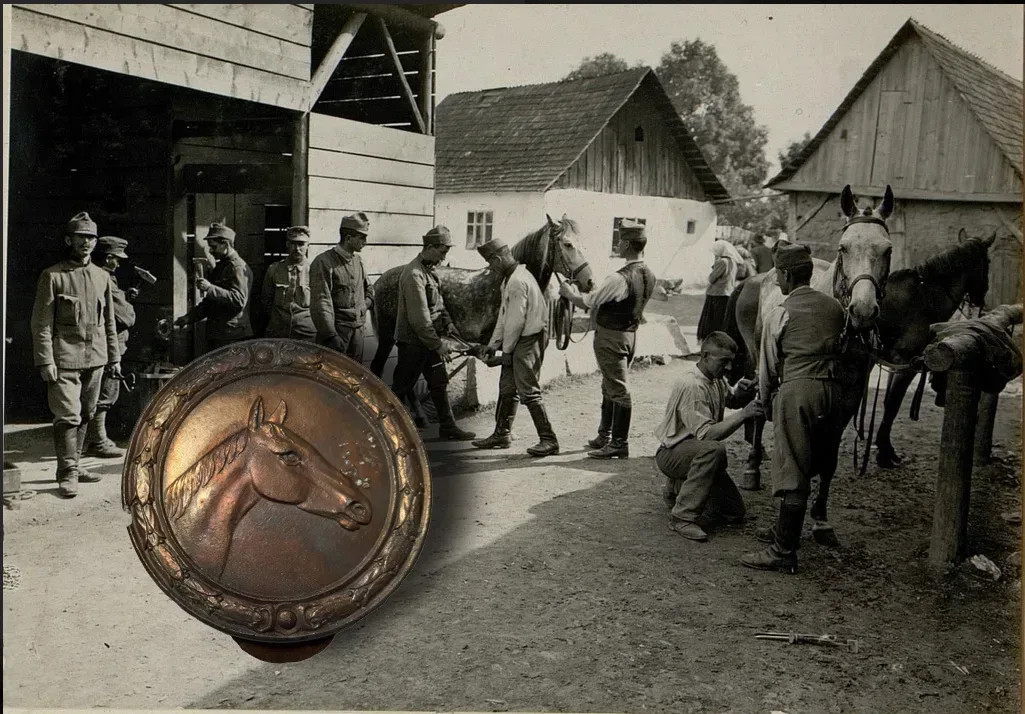Skillful grooms’ badge
The new post of Gábor Széplaki is about another horse-related skill.
The entire army of the Monarchy, taking into account joint army, Honvéd and Landwher troops, included 54 cavalry regiments. These employed approximately 70,000 horses in peacetime. In 1914, after mobilization, half a million more animals were needed to completely fill up the army needs. About 30% of this was ordered to the cavalry regiments. The moving warfare in Galicia, as well as the struggle against outnumbered Russians have caused enormous damage to both humans and horses in the cavalry regiments. Long distances were ridden by these units, fighting, weather, difficult terrain conditions, and inadequate care, horribly used up the horse stock. So much so that by the end of the first year of war, about a quarter of the original horse population was available in the cavalry regiments. The rest were either dead or withdrawn injured/sick into the back lines to the horse hospitals and horse resting stations.
A similar situation existed in mounted artillery and train corps, but sources said horse losses were even higher. The problem was further exacerbated since the Monarchy was obliged to hand over 100,000 horses to the German Ally, in addition to replacing the above gaps. In 1915, 870,000 war-fit animals were recorded in the horse count held. That number rose to 944,000 the following year. In 1916, the army lost 8,000 horses a week, mainly due to a lack of feed. Despite all this, 970,000 horses were counted in the use of the army in 1917. By this time, the replacement of the losses was becoming increasingly difficult. In particular, due to the increasing horse needs of artillery, horse shortages have been caused in the hinterland, especially in agriculture. The military was trying to remedy this problem. Due to changes in warfare/combat, the cavalry regiments were already fighting on foot. Therefore, the vast majority of the horse population of the cavalry regiments was transferred to the artillery and train corps.

It is clear from the above that the importance of trained horses in the corps has been more valued than before. For all types of weapons, the crew took care of their horses. In the cavalry corps, the enlisted peasant children also brought with them distinguished care of the animals from home, where on farms the horse made living and daily life easier. Official horse grooms were selected from the crew enlisted in the corps to care for the officers’ horses. Preferably those whose civic life/work was somehow linked to this kind of activity (e.g. groom, coach, foal, etc.).
At the end of the 1800s, horse grooms wore a right-angled triangle made of a red trimming on the right sleeve of the jacket near the wrist as a distinctive mark. In an order (71754/7 published on March 12, 1917), a medal was awarded to soldiers in that position, in addition to the farriers’ skill badge. “The medal is awarded to trusted crew individuals who stand out through the excellent nursing, good care and treatment of the horses entrusted to them.”

According to the order, these badges were made of tombac or red casts. The badge was created in several material variations and by several badge manufacturers. The image in this post shows two war metal specimens, one coated with a gold/bronze overlay. The manufacturer used the EM signal in the fastening tabs, but unfortunately no documentation has been found to resolve this sign. Also known are other versions: thick copper with Zimbler’s punch and a thinner one pressed from iron plate. The badge is 440-450 mm in diameter. At the 110-120 mm edge, a prominent laurel wreath runs around, which is held together by a round buckle at the height of 12 and 6 hours. In the middle, you can see a convex horse head with an artistic design overlooking to the right. It has a vertically soldered, flattened Ω-shaped fastener on the back. Its wearing was prescribed above the right pocket of the jacket. The medal was awarded by the commander on the recommendation of the subdivision commander.




